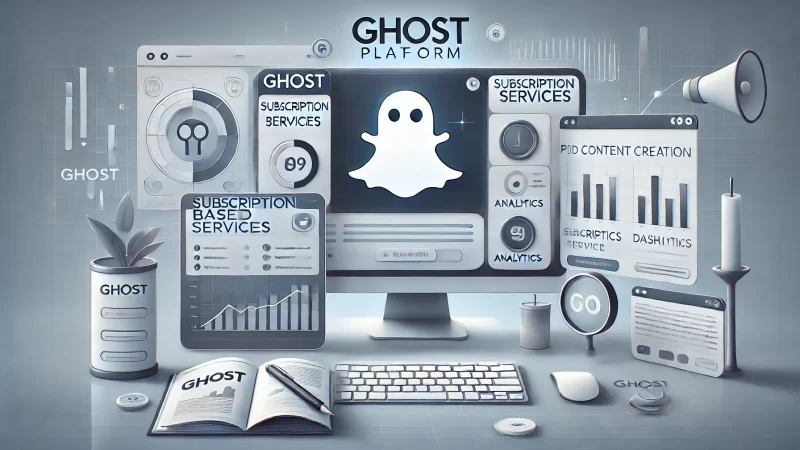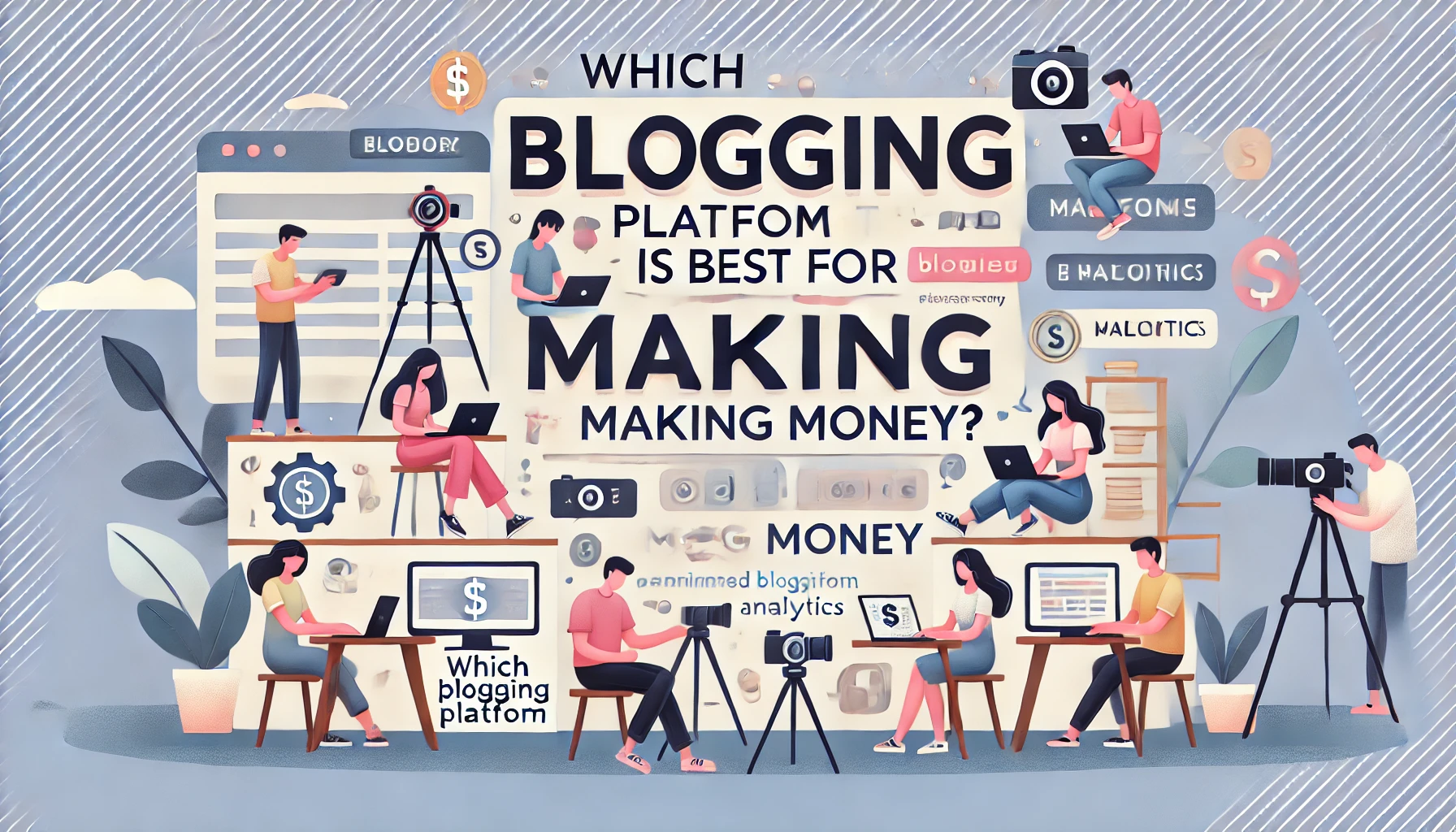Which blogging platform is best for making money? In a saturated digital market, finding the right platform to maximize revenue is essential.
This guide dives deep into each popular blogging platform, comparing monetization potential, audience reach, and ease of use to help you make an informed choice.
Key Factors For Choosing A Blogging Platform
When considering which blogging platform is best for making money, several factors stand out. Knowing the strengths and limitations of each platform allows you to align your blogging goals with the platform’s unique features, maximizing your earnings.
Understanding Monetization Options On Each Platform
Different platforms offer various ways to make money, like ads, subscriptions, and affiliate marketing. I suggest exploring each platform’s options to understand how you can monetize effectively, choosing one that matches your goals and audience needs.
Monetization options are not just about ads or affiliate links but also include direct subscriptions, premium content, and product sales. The more options a platform provides, the better it supports diverse revenue strategies, helping you find what works best for you.
For example, platforms like WordPress support plugins for ads, memberships, and e-commerce, allowing you to combine multiple income streams. Other platforms, like Medium, are limited to certain models, which may not suit everyone’s needs.
Finding a platform with flexible monetization options allows you to experiment and find your most profitable path, which I believe is essential for long-term blogging success.
Ease Of Use For Beginners And Pros
Ease of use is critical, whether you’re a beginner or an experienced blogger. Some platforms are straightforward, while others have a steeper learning curve. I recommend choosing a platform that matches your technical comfort and time commitment.
Platforms like Wix and Blogger are known for their user-friendly interfaces, making them ideal for beginners. These platforms simplify design and setup, allowing you to focus on content without needing extensive technical skills.
On the other hand, WordPress offers advanced customization options but requires some technical knowledge. If you’re comfortable with tech, WordPress could be worth the extra effort, as it opens up more revenue opportunities.
The right platform should balance ease of use with functionality, ensuring you can grow your blog as your skills improve. I believe this approach keeps blogging enjoyable and sustainable.
How Platform Scalability Impacts Earnings
Scalability is about how well a platform can grow with your needs, which can impact your earnings. Starting with a scalable platform allows you to expand and add features as your blog gains popularity and revenue potential.
For instance, WordPress allows you to add plugins, integrate third-party tools, and scale up your hosting as your audience grows. This scalability can be crucial for bloggers looking to turn their platform into a full-time income source.
In contrast, simpler platforms like Medium or Blogger may limit scalability, which could restrict your earning potential as you grow. I advise choosing a platform that supports growth if you plan to make blogging a primary income source.
Selecting a platform with strong scalability means fewer transitions later on, saving you time and helping you maximize earnings without switching platforms frequently.
Integrating SEO And Marketing Tools For Profitability
SEO and marketing tools are essential for maximizing your blog’s visibility and income. Platforms offering SEO integration and marketing features can boost your search engine ranking, driving more traffic and revenue.
WordPress, for example, supports a wide range of SEO plugins, allowing for advanced optimization. With tools like Yoast SEO, you can improve on-page SEO, which I believe is crucial for long-term traffic growth and income potential.
Platforms like Wix and Squarespace also have built-in SEO tools, but they’re generally less comprehensive than those on WordPress. For bloggers focusing heavily on SEO, a platform with robust SEO tools will likely bring better results.
Using a platform with marketing and SEO features will enhance profitability, as it helps attract more visitors who convert into loyal readers, subscribers, or customers over time.
Choosing A Platform Based On Audience Targeting
Your ideal audience plays a big role in choosing the best blogging platform for making money. I suggest picking a platform that aligns well with your audience’s habits and preferences, helping you reach and engage them effectively.
Platforms like Substack cater well to niche audiences, which can be lucrative if you’re targeting a specific readership. Conversely, WordPress supports broad customization, so it’s versatile for different audience types and niches.
Understanding your audience’s needs and where they’re most active can help you select a platform they’ll engage with. For example, a creative-focused audience might respond well to a visually appealing platform like Squarespace.
Choosing the right platform based on your audience helps you attract loyal followers who are more likely to support your monetization strategies, increasing your blog’s profitability.
WordPress: Powerful Platform With Endless Potential

WordPress offers a versatile platform for bloggers seeking high earning potential. With its range of monetization tools, customization features, and strong SEO capabilities, WordPress provides ample opportunities to maximize your blog’s income.
How WordPress Monetization Tools Drive Income
WordPress supports a variety of monetization tools, from ads to memberships. I recommend leveraging plugins to enable ads, affiliate links, or even e-commerce, as these tools open multiple revenue streams for consistent income growth.
Ad plugins like Ad Inserter help place ads without manual coding, while WooCommerce enables product sales directly from your blog. Combining these tools gives you flexibility in how you generate revenue, maximizing your earnings.
Membership plugins like MemberPress offer options for paid content, allowing readers to access exclusive material. This feature can be particularly lucrative for bloggers with valuable, niche content.
Utilizing WordPress’s diverse monetization options, I believe, enhances income potential by enabling varied, reliable revenue streams that suit different blogging niches and strategies.
Customization And Control: A Key To Higher Profits
WordPress’s customization capabilities are unmatched, allowing you to tailor your blog’s look and functionality for maximum user engagement. Customization impacts reader experience, which in turn can drive higher profits.
With access to thousands of themes and plugins, you can design a unique, branded experience for your audience. This level of control over your blog’s design and features is ideal for creating a memorable impression on visitors.
Customization options also extend to SEO and monetization, letting you optimize every element for income generation. I recommend WordPress if you need a flexible platform where you control content and design aspects.
By customizing your blog to meet your audience’s preferences, you enhance their experience and increase the likelihood of repeated visits, which supports consistent income.
SEO Plugins And Their Impact On Revenue Growth
WordPress’s SEO plugins play a huge role in helping bloggers drive organic traffic, which boosts revenue. Using SEO tools effectively can attract more readers, creating a steady flow of visitors who engage with your monetization strategies.
Plugins like AIOSEO and Rank Math offer in-depth optimization, allowing you to target keywords, structure content, and improve technical SEO. I advise focusing on these aspects to rank higher and attract more clicks from search engines.
Higher search visibility means more traffic, and with effective monetization, this can significantly increase your income. An optimized site draws readers, who are then more likely to engage with ads or affiliate links.
Utilizing SEO plugins on WordPress supports long-term growth, as more organic traffic translates into steady, passive income opportunities for dedicated bloggers.
Understanding Costs: Free vs. Self-Hosted WordPress
WordPress offers both free and self-hosted options, each with different costs and benefits. I recommend understanding these choices thoroughly, as your investment impacts the features you can access and your blog’s growth potential.
The free version limits customization and monetization, which can restrict income. Self-hosted WordPress, while requiring hosting fees, provides full control over ads, plugins, and themes, allowing greater earning potential.
Costs for self-hosted WordPress include domain registration, hosting, and possibly premium plugins or themes, depending on your needs. Despite the expense, I believe the added monetization options justify the cost for serious bloggers.
Evaluating these cost differences helps you choose the version that aligns with your budget and income goals, ensuring that you maximize earnings from your WordPress blog.
Leveraging WordPress For Affiliate Marketing
Affiliate marketing on WordPress is a strong income strategy, thanks to plugins that simplify link management and tracking. I suggest focusing on affiliate partnerships that match your niche to increase earnings from readers genuinely interested in your recommendations.
Plugins like ThirstyAffiliates organize and track links, making it easy to add affiliate content naturally into your posts. This tool helps you monitor which links perform best, guiding your strategy for better results.
Successful affiliate marketing requires trust, so I recommend only promoting products or services that you personally believe in. This builds credibility, increasing the chances that readers will purchase through your links.
By integrating affiliate marketing on WordPress, you can create a reliable income source, as genuine product recommendations often lead to higher conversions and consistent earnings.
Wix: Easy Setup With Promising Profit Opportunities

Wix provides an accessible platform with simple tools that make it easy for new bloggers to start earning. Its drag-and-drop builder and monetization options help users turn their content into revenue without extensive technical knowledge.
Wix Monetization Features For New Bloggers
Wix supports various monetization features that help new bloggers earn from the start. With tools like AdSense integration and e-commerce options, Wix enables bloggers to quickly explore revenue avenues that suit their content and audience.
AdSense is a popular choice for Wix users, allowing bloggers to earn from ad placements on their site. This feature is straightforward, making it an appealing option for beginners wanting an easy way to monetize their blog.
Wix also offers an integrated e-commerce solution, ideal for bloggers who wish to sell products or services. This setup combines content and sales, creating an additional income stream directly from their website.
Membership and subscription options on Wix allow bloggers to create paid, exclusive content. I believe this feature is especially valuable for bloggers who have a dedicated audience willing to support their work financially.
Comparing Wix’s SEO Capabilities To Other Platforms
Wix includes SEO tools that help improve your blog’s visibility, although it has limitations compared to platforms like WordPress. I recommend exploring these tools for on-page SEO improvements, especially if you’re new to optimizing for search engines.
Wix’s SEO Wiz provides a guided setup, making it user-friendly for beginners. This feature suggests steps to enhance rankings, such as optimizing titles and meta descriptions, helping bloggers attract more visitors organically.
While Wix offers basic SEO functions, it lacks advanced capabilities like those available on WordPress. If SEO is central to your strategy, consider how Wix’s limitations may impact your long-term goals for ranking and traffic growth.
Integrating Google Analytics with Wix can provide insights into traffic patterns and reader engagement. Monitoring these metrics is essential for bloggers aiming to increase visibility, and I suggest making full use of this data to refine your SEO approach.
Pros And Cons Of Wix For Making Money
Wix has advantages and drawbacks when it comes to monetization, so understanding both can help you decide if it’s the right choice. I believe Wix is a solid start for beginners, although it may have limitations for advanced bloggers.
One of the main benefits is Wix’s user-friendly interface, which simplifies site setup and management. For new bloggers, this ease of use can make monetization straightforward, without needing to navigate complex backend settings.
However, Wix’s customization options are somewhat limited, especially when compared to platforms like WordPress. This can restrict your ability to add advanced features that might enhance revenue potential as your blog grows.
The pricing on Wix is also worth considering. Although affordable, some premium features require additional costs, which could impact profitability. Carefully evaluating these expenses can help you make the most of Wix’s monetization tools.
Wix Premium Plans And Earnings Potential
Wix’s premium plans unlock additional features that can boost your earning potential. These plans offer increased storage, better SEO, and more customization, which I suggest for bloggers seeking to expand their reach and profitability.
The “Combo” and “Unlimited” plans are popular for bloggers, offering ad-free experiences and enhanced bandwidth. Choosing one of these options can improve user experience, attracting more readers and potentially increasing revenue.
Wix’s premium plans also support more extensive e-commerce functions, which are useful if you’re interested in selling products. Upgrading to these plans can transform your blog into a hybrid of content and commerce.
With premium access, bloggers can unlock advanced SEO tools and data analytics, offering valuable insights for content strategy. These upgrades allow you to tailor your blog’s monetization approach based on traffic and engagement patterns.
Medium: Unique Blogging Platform For Monetization
Medium stands out as a platform for monetization, offering bloggers direct income through its Partner Program. With a unique focus on reader engagement and reach, Medium provides a promising option for bloggers aiming to earn while building an audience.
Medium’s Partner Program And Revenue Potential
The Partner Program on Medium allows bloggers to earn based on reader engagement. This model rewards writers for valuable content, making it an attractive option for bloggers focused on high-quality, engaging posts.
Earnings are driven by reader interactions, such as time spent reading and claps. I suggest creating content that resonates deeply with readers to maximize earnings, as Medium’s model prioritizes meaningful engagement over simple views.
With Medium’s Partner Program, income is subscription-based, meaning you earn a portion of subscriber fees. This model can be highly profitable for bloggers with a strong following who actively support their work.
Medium’s unique payment structure can suit bloggers who are passionate about writing rather than advertising. This approach may appeal to those focused on storytelling, insights, or educational content over commercial-style blogs.
Medium Audience Reach And Earnings Growth
Medium has a built-in audience, which can boost a new blogger’s visibility and income potential. I recommend utilizing this audience to gain traction faster, as Medium promotes engaging content to its readers, helping you attract followers.
The platform’s distribution model highlights popular posts, increasing exposure. Creating insightful, well-crafted articles can help you leverage Medium’s reach, as popular posts often attract substantial readership.
Engaging with Medium’s community through comments and follows can also grow your reach, making it easier to build a supportive readership. A dedicated audience on Medium can lead to a steady income through the Partner Program.
I believe Medium’s structure is excellent for bloggers who value community and reader interaction, as engagement is central to income growth. Building connections on Medium can amplify your content’s impact and earnings.
Limitations And Advantages Of Medium For Blogging
While Medium offers great benefits, it has certain limitations. Knowing these can help you decide if it’s the best blogging platform for making money or if another platform might better suit your goals.
One limitation is that you don’t fully own your audience on Medium, as it controls the platform and its algorithms. I advise considering this if you’re looking to build a personal brand that extends beyond Medium.
However, Medium’s emphasis on quality content means your posts may reach readers who genuinely appreciate your work. This focus on engagement can be rewarding for bloggers who prioritize content over technical aspects of website management.
Another advantage is the simplicity of Medium’s interface, making it easy to publish without distractions. I suggest Medium for those who want to focus on writing without handling technical tasks, as the platform handles most backend details.
For bloggers seeking full ownership of their content and monetization strategies, Medium’s limitations may be a drawback. However, for pure writers, Medium’s audience reach and engagement model are solid benefits.
Monetization Options Beyond The Partner Program
Beyond the Partner Program, Medium offers other monetization avenues that can benefit bloggers. I believe diversifying your income on Medium can be advantageous, especially if you’re growing a loyal, engaged audience.
One option is promoting external content or services. Bloggers can link to their own products or services within their Medium articles, subtly generating income without disrupting the reader experience.
Affiliate marketing can also work on Medium, though it requires thoughtful integration. I suggest using affiliate links sparingly to maintain trust with your readers, as Medium’s audience tends to value authenticity.
If you have premium content, consider directing readers to other platforms for subscriptions or purchases. This approach can generate income while keeping Medium as a central content hub for broader reach.
Offering consulting services or workshops based on your content expertise is another way to monetize beyond the Partner Program. For bloggers with a strong niche following, this strategy can turn Medium readers into paying clients.
Substack: Profitable Platform For Niche Audiences

Substack offers bloggers a direct income path by allowing subscriptions and donations, making it ideal for niche writers aiming to earn from dedicated readers. This model fosters a loyal following willing to pay for valuable, unique content.
Substack Revenue Models: Subscriptions And Donations
Substack’s revenue model relies on subscriptions and donations, offering bloggers predictable income streams. I suggest focusing on high-quality content to entice readers to subscribe, as this model rewards loyal supporters willing to invest in your work.
With subscriptions, bloggers can set monthly or yearly fees for exclusive content, creating consistent income. This model appeals to readers who want ongoing access to valuable insights, allowing writers to develop a sustainable income.
Substack also enables one-time donations, letting readers support their favorite creators without a long-term commitment. This option can be particularly appealing to newer audiences, offering a more flexible way to contribute.
Balancing subscriptions and donations on Substack helps bloggers maximize earnings. I recommend experimenting with both methods to determine which generates the most support based on your audience’s engagement and preferences.
How Substack Favors Niche Bloggers
Substack is particularly beneficial for niche bloggers, as its audience often values specific, specialized content. I advise writers focusing on narrow topics to consider Substack, where unique expertise tends to thrive among loyal readers.
Niche content often attracts dedicated followers who are more willing to pay for exclusive insights, especially if they can’t find it elsewhere. Substack’s structure supports this by allowing writers to monetize specialized knowledge effectively.
Compared to broader platforms, Substack encourages deeper connections with readers, which is ideal for bloggers offering unique or expert viewpoints. This loyalty translates into a reliable subscriber base, enhancing income potential.
I believe Substack’s emphasis on community suits bloggers who enjoy engaging with their readers and building a dedicated following around a specific topic, helping monetize passion-driven content successfully.
Subscriber Growth Tactics For Higher Earnings
Growing a subscriber base on Substack is key to increasing earnings, and there are effective ways to achieve this. I recommend using social media and email marketing to promote your Substack, expanding your reach and visibility.
Offering a mix of free and paid content can attract new subscribers by letting them sample your work before committing. I suggest providing valuable free content to build trust, which can then lead readers to upgrade to paid subscriptions.
Hosting Q&A sessions or webinars as exclusive perks can also entice subscribers. These added benefits deepen the relationship with your audience, making it more likely they’ll support your work through paid subscriptions.
Engaging with readers through comments and responding to feedback can foster a supportive community. I’ve found that a strong community increases subscriber loyalty, leading to higher long-term earnings on Substack.
Comparing Substack’s Paywalls With Other Platforms
Substack’s paywall model allows for flexible income strategies, making it easy to control what content is free or exclusive. I suggest comparing Substack’s approach with platforms like Patreon to determine which suits your content goals best.
Substack’s paywall is straightforward, giving bloggers control over which articles remain free and which are paid. This setup allows writers to keep some content accessible, attracting new readers while offering premium content for subscribers.
Unlike other platforms, Substack doesn’t require extensive customization for paywalls, keeping it simple for those who want to focus on writing. This simplicity appeals to bloggers who prioritize content over technical adjustments.
For bloggers who value community and ease of setup, I believe Substack’s paywall is highly effective. It supports income growth by blending free and paid content seamlessly, making it easier to attract and retain subscribers.
Blogger: Simple Platform With Basic Monetization Options
Blogger is a straightforward platform with limited but accessible monetization options. Ideal for beginners, Blogger’s simplicity and Google AdSense integration make it a basic yet effective choice for bloggers starting to earn income online.
AdSense Integration And Income Potential On Blogger
Google AdSense integration is Blogger’s primary monetization tool, allowing bloggers to earn from ad placements. I suggest setting up AdSense if you’re just starting, as it requires minimal effort and can yield steady income over time.
AdSense automatically displays relevant ads, which can generate passive income as your blog grows in traffic. This model is ideal for beginners, providing a simple way to earn without managing complex affiliate or product sales.
However, earnings from AdSense rely heavily on traffic volume. I advise focusing on building a substantial audience, as higher traffic increases ad impressions, ultimately boosting income potential.
While AdSense is effective for beginners, exploring other income streams as your blog grows may enhance earnings. Blogger’s limited monetization options mean diversifying is beneficial if you plan to increase income long-term.
Pros And Cons Of Blogger For Earning Money
Blogger offers advantages and drawbacks when it comes to making money. I believe Blogger is great for beginners due to its simplicity, but limited features may restrict earnings for advanced users seeking more monetization tools.
Blogger’s ease of use and integration with Google AdSense make it a beginner-friendly choice. This simplicity allows new bloggers to focus on content creation without worrying about technical setup, making monetization more accessible.
However, Blogger lacks customization, which can limit the ways you monetize or tailor your site. Advanced bloggers might find this restrictive, especially when compared to platforms with more plugins and revenue options.
For those wanting a straightforward, free platform with basic income opportunities, Blogger is useful. But as your goals evolve, you might need a more flexible platform to support diverse monetization methods.
Blogging Limitations Of Blogger’s Free Model
Blogger’s free model comes with limitations that can affect your growth and income. I suggest being aware of these restrictions, especially if you plan to turn your blog into a substantial revenue source over time.
Customization is limited on Blogger, restricting how much you can personalize your site’s appearance and features. This may impact reader experience, as it’s harder to stand out visually or add advanced functionalities for monetization.
Blogger’s free hosting also affects your site’s branding. Your domain includes “.blogspot.com,” which may seem less professional to some readers, potentially influencing their willingness to engage with paid content.
For bloggers aiming to build a strong brand, these limitations can be a drawback. I advise considering how important customization and branding are for your goals when deciding if Blogger’s free model is suitable.
Analyzing Blogger’s Target Audience And Reach
Understanding Blogger’s typical audience can help determine its potential for monetization. I recommend using Blogger if you’re targeting readers who value accessible, straightforward content rather than those seeking exclusive, high-end material.
Blogger attracts a broad, casual audience, which may limit premium monetization options like subscriptions. This general audience typically prefers free content, so ads may perform better than paywalls on this platform.
For niche content, Blogger’s reach may be limited since it lacks strong SEO tools and advanced marketing features. This can restrict how widely your posts are seen, impacting traffic and, in turn, ad earnings.
Using Blogger is beneficial if you’re focused on sharing accessible content with minimal technical setup. However, if your goal is niche monetization or targeting a specific, engaged audience, other platforms might offer better options.
Ghost: Robust Platform For Paid Content

Ghost is designed for bloggers who prioritize paid content, providing robust tools for subscriptions and branding. Its focus on supporting serious, revenue-driven blogging makes Ghost ideal for those building a dedicated, paying audience.
Ghost’s Subscription Model For Sustainable Income
Ghost’s subscription model enables bloggers to earn consistently by offering exclusive content to subscribers. I believe this setup is perfect for those aiming to develop a reliable income source through monthly or yearly memberships.
With Ghost, bloggers can create tiers for subscribers, providing varying levels of access. This tiered structure can enhance earnings by allowing readers to choose a level that fits their budget, supporting long-term income stability.
Subscribers gain access to premium content, creating value and justifying their investment. This model is effective for bloggers offering high-quality insights or specialized information that readers are willing to pay for.
For consistent revenue, I suggest building a strong subscriber base on Ghost. Its model favors bloggers dedicated to providing unique, valuable content that appeals to a loyal audience.
Benefits Of Ghost For Monetized Content Control
Ghost’s platform provides full control over monetization, which can be valuable for bloggers who want flexibility. I recommend Ghost for those needing advanced customization to align content, branding, and revenue strategies.
Unlike other platforms, Ghost doesn’t rely on third-party tools for subscriptions, giving you direct control over subscriber management. This setup simplifies revenue tracking and subscriber engagement, supporting a smoother content operation.
Ghost also allows for complete branding, enhancing the professional feel of your blog. Strong branding can boost your audience’s trust and commitment, making them more likely to support you financially through subscriptions.
I believe Ghost’s control over monetization is ideal for bloggers focused on building a business-like platform where they manage all aspects of income and reader relationships.
Customization And Branding Options On Ghost
Ghost offers extensive customization and branding features, making it suitable for bloggers aiming to create a unique, professional site. Customization lets you design a blog that resonates with your audience, enhancing their experience and your branding.
Ghost supports custom themes and layouts, allowing you to tailor your blog’s appearance to align with your brand. This feature is beneficial for bloggers who want a visually cohesive site that strengthens their connection with readers.
Personalized branding on Ghost can also build trust, which is essential for subscription-based income. Readers who see a well-crafted, branded experience are often more willing to pay for exclusive content.
Ghost’s customization options also extend to content structure, allowing bloggers to organize posts in ways that enhance reader navigation and engagement. This structure is key to creating a professional, reader-focused experience.
Pricing Considerations And Revenue Projections
Ghost’s pricing structure is geared toward serious bloggers who plan to monetize. Although it requires an upfront investment, I suggest assessing your revenue potential to determine if Ghost’s subscription cost is feasible for your goals.
Ghost’s subscription fees support its extensive features, which can lead to higher earnings for those dedicated to a content-driven business. I recommend evaluating the platform’s cost against its monetization tools to gauge profitability.
Compared to free platforms, Ghost’s fees may seem high, but its robust capabilities justify the cost for income-focused bloggers. Bloggers who plan to generate substantial income from subscriptions may find Ghost’s tools worth the investment.
Understanding Ghost’s revenue projections helps you make an informed decision. For bloggers with a clear income strategy, Ghost’s structure supports sustainable growth, especially for those committed to consistent, high-quality content creation.
Squarespace: High-Potential Platform For Creatives
Squarespace provides creatives with a visually appealing platform that supports monetization. I suggest Squarespace if you focus on visual content and want a streamlined site with built-in e-commerce and marketing tools to maximize revenue potential.
Monetizing Visual Content On Squarespace
Squarespace is ideal for monetizing visual content, offering design tools that make images, videos, and graphics shine. This setup suits photographers, designers, and artists who rely on aesthetic appeal to engage visitors and encourage purchases.
With features like customizable galleries, you can create a portfolio that showcases your work beautifully. These galleries support image-focused blogs and enable visitors to explore your offerings, building interest in your paid products.
Squarespace also supports video hosting, allowing creatives to share tutorials or premium visual content. I believe adding video can enrich visitor experience, particularly for bloggers who offer unique insights or educational material.
Its integration with Adobe Creative Cloud makes it easier for designers to incorporate high-quality visuals. This compatibility can help you present your work professionally, creating a strong first impression that attracts paying customers.
Squarespace’s E-commerce Integration For Bloggers
Squarespace’s e-commerce features make it easy to sell directly from your blog. I recommend using these tools if you’re interested in turning your blog into a shop, as they simplify product listing, checkout, and payment processes.
Squarespace’s inventory management and payment integrations support a full e-commerce setup. For bloggers offering digital or physical products, these features streamline the shopping experience, encouraging readers to make purchases.
Adding promotional features, like discounts and gift cards, can enhance sales. These options allow you to engage your audience with special offers, which I find valuable for bloggers aiming to boost conversion rates.
Selling directly from a Squarespace blog allows for seamless integration between content and commerce. This makes it easier to monetize blog posts by linking relevant products, creating a cohesive experience for readers and buyers alike.
SEO And Marketing Features That Drive Profits
Squarespace includes essential SEO and marketing tools that help attract and retain readers. I advise using its SEO features, such as meta tags and URL customization, to optimize visibility, especially if search engines are a primary traffic source.
Squarespace’s email marketing integrates directly with your blog, allowing you to create email campaigns that engage readers. For bloggers, this feature is useful for building a subscriber base and promoting new posts or products.
Social media integrations enable content sharing, expanding reach and boosting traffic. Connecting your Squarespace blog with social accounts can bring in a larger audience, which can translate into more monetization opportunities.
Its analytics tool helps track visitor behavior, offering insights into what content performs best. This data allows you to refine your strategy, focusing on posts that resonate most with readers and drive the highest profits.
Comparing Squarespace To Other Platforms For Revenue
Squarespace stands out among other platforms with its design focus and e-commerce tools. While it’s ideal for creatives, I suggest considering how its limited customization compares to platforms like WordPress for those wanting more flexibility.
Squarespace’s all-in-one setup is simpler but offers fewer plugins than WordPress. This trade-off may suit bloggers who want a low-maintenance site but might limit growth for those needing advanced functionality.
Compared to Shopify, Squarespace offers a more visually driven experience, which is valuable for artists but may not suit all types of bloggers. For e-commerce-driven content, Shopify might provide better features tailored to sales.
For a creative focus, Squarespace excels, but other platforms like WordPress offer more depth for SEO and customization. I suggest evaluating your priorities to see if Squarespace’s streamlined, visual experience aligns with your goals.
Shopify: E-commerce Blogging For Revenue

Shopify combines blogging with e-commerce, making it ideal for product-focused bloggers. With robust sales tools and a blog section, Shopify helps you integrate content with commerce, appealing to readers ready to make purchases.
Shopify As A Blogging Platform For Product Promotion
Shopify’s blog feature supports content that promotes products, helping readers understand your offerings. I suggest using this feature to provide educational content that complements your products, adding value for both casual readers and customers.
Blogging on Shopify can boost SEO, helping your store reach more visitors. Writing product-related articles increases visibility, and targeted keywords drive organic traffic, creating a pathway from content to purchase.
Integrating product links within blog posts enables seamless shopping. Readers can easily transition from reading a blog to buying, making Shopify’s blog feature a natural fit for bloggers focused on driving sales.
With Shopify’s emphasis on e-commerce, I believe it’s perfect for bloggers who want content to directly support product sales, blending information with a strong call to action that guides readers toward purchase decisions.
Integrating Blogs With E-commerce For Better Profits
Shopify’s integration of blogs with e-commerce lets you build a cohesive shopping experience. I recommend creating informative posts that address common questions, as these articles can drive traffic while supporting product understanding.
Adding product reviews or guides on your Shopify blog can enhance buyer confidence, guiding readers toward informed purchases. This type of content builds trust and encourages conversion, especially for high-ticket items.
Seasonal or trending content can highlight product relevance, making your offerings more appealing. This strategy connects blog topics with current events, encouraging readers to consider purchases tied to timely themes.
Offering exclusive deals or discounts through blog content can boost sales by creating urgency. I suggest featuring time-sensitive offers to attract readers who appreciate special promotions, which can enhance your e-commerce revenue.
Shopify Apps To Increase Earnings Through Blogging
Shopify’s app store offers tools to enhance your blog’s monetization. Apps like SEO Manager and Blog Studio improve visibility and customization, which I recommend exploring to increase traffic and create a polished, engaging blog.
SEO apps help optimize your blog for search engines, attracting organic traffic to your Shopify store. I believe SEO Manager is valuable for reaching new audiences, as it enhances keywords, meta tags, and alt text to boost rankings.
Blog Studio allows for more customization in blog layout, making your content visually engaging. This app can elevate your blog’s design, which is particularly useful for blogs that emphasize branding and product storytelling.
Affiliate and referral apps enable partnerships that further monetize your content. By promoting complementary products, you can earn commissions, diversifying income without relying solely on product sales within your store.
Shopify’s Audience Reach For Maximizing Revenue
Shopify’s marketing tools expand your blog’s audience, essential for maximizing revenue. Integrating social media, email marketing, and ads with your Shopify blog brings in readers who are likely interested in your products.
Shopify’s email marketing tools allow you to segment audiences, sending targeted messages based on their behavior. For bloggers, this means promoting relevant content and products to the right audience, improving engagement and sales.
Social media integration enables seamless sharing, which can draw more readers to your blog. I recommend connecting your Shopify blog to your social accounts to reach new audiences and promote content directly linked to your store.
Shopify’s analytics also provide insights into blog performance and visitor behavior. Tracking which posts drive the most traffic or conversions can help refine your strategy, focusing on content that maximizes reader engagement and profits.
Comparison: Best Blogging Platforms For Monetization
Comparing the best blogging platforms for monetization can guide you in choosing the one that aligns with your income goals. Each platform offers unique strengths, so I suggest selecting based on your blog’s needs and long-term objectives.
WordPress vs. Wix: Which Yields Higher Profits?
WordPress provides more monetization options and customization, ideal for bloggers seeking diverse income streams. Wix, though user-friendly, is limited in flexibility, which may affect long-term profit potential as your blog expands.
WordPress supports plugins for ads, e-commerce, and affiliate marketing, enhancing revenue potential. Wix’s simplicity suits beginners, but advanced bloggers may find WordPress offers greater control over monetization strategies.
SEO plugins on WordPress allow for deeper optimization, driving more organic traffic. Wix’s SEO is less robust, which can limit growth for bloggers aiming to scale and increase revenue through search engine rankings.
For experienced bloggers aiming for high profits, I believe WordPress offers better tools. However, Wix’s ease of use may be preferable for newcomers focused on simplicity rather than extensive monetization options.
Medium vs. Substack: Ideal Platforms For Niche Markets
Medium and Substack each cater to niche audiences, but their monetization models differ. Medium’s Partner Program pays based on reader engagement, while Substack relies on subscriptions, suiting bloggers with loyal, niche audiences.
Medium’s model rewards high-quality, engaging posts that attract readers. For bloggers who prefer passive income based on content performance, Medium is a good choice for gaining income without actively managing subscriptions.
Substack’s subscription model favors bloggers who provide in-depth, valuable content. I suggest Substack if you enjoy building a dedicated reader community willing to support your work through paid memberships.
Both platforms serve niche markets, but Medium is ideal for passive income, whereas Substack appeals to bloggers seeking consistent subscriber income through direct reader support.
Ghost vs. Blogger: Best Choice For Professional Income
Ghost and Blogger differ significantly in monetization potential. Ghost’s subscription model is ideal for professional bloggers focused on paid content, while Blogger’s ad-centric approach is more basic, suiting beginners or hobbyists.
Ghost’s customizable subscription tiers enable sustainable income by offering exclusive content. This model supports professional bloggers who want to monetize deeply, creating a business around their blog’s specialized content.
Blogger’s AdSense integration offers easy monetization but is limited to ads, which may cap earning potential. This approach suits those seeking simplicity over a full-fledged income from paid content or memberships.
For bloggers aiming for serious income, I believe Ghost offers more robust tools. However, Blogger’s straightforward setup might appeal to newcomers who prioritize ease over high earning potential.
Shopify vs. Squarespace: E-commerce Blogging Comparison
Shopify and Squarespace each support e-commerce, but Shopify is tailored for sales, while Squarespace balances commerce with design. I suggest Shopify if products are central, while Squarespace suits visually driven blogs with secondary sales.
Shopify’s app ecosystem supports advanced e-commerce functionality, ideal for product-heavy blogs. Squarespace, while capable, focuses more on design, which is perfect for creatives who prioritize aesthetics alongside limited product offerings.
Shopify’s analytics and sales tools make it easy to track revenue, which can help bloggers refine their sales approach. Squarespace offers less in-depth e-commerce tracking, limiting insights for bloggers focused on scaling sales.
For a sales-focused blog, Shopify excels. Squarespace’s blend of visuals and commerce may suit bloggers who want e-commerce as a secondary feature to their content.
Key Takeaways: Selecting The Best Blogging Platform
Choosing the best blogging platform depends on your monetization goals and audience needs. WordPress and Shopify are ideal for revenue-driven blogs, while Medium and Substack cater to niche communities seeking subscription-based support.
Platforms like Ghost and Squarespace provide professional customization, making them suitable for brand-focused blogs. Blogger offers simplicity, appealing to beginners but with limited growth potential compared to more advanced options.
Understanding each platform’s strengths allows you to select one that aligns with your objectives. I recommend considering your long-term vision, as the right choice supports your growth and maximizes income opportunities.
Balancing functionality with income potential is crucial for effective monetization. With this guide, you can choose a platform that helps turn your blogging efforts into sustainable earnings.






